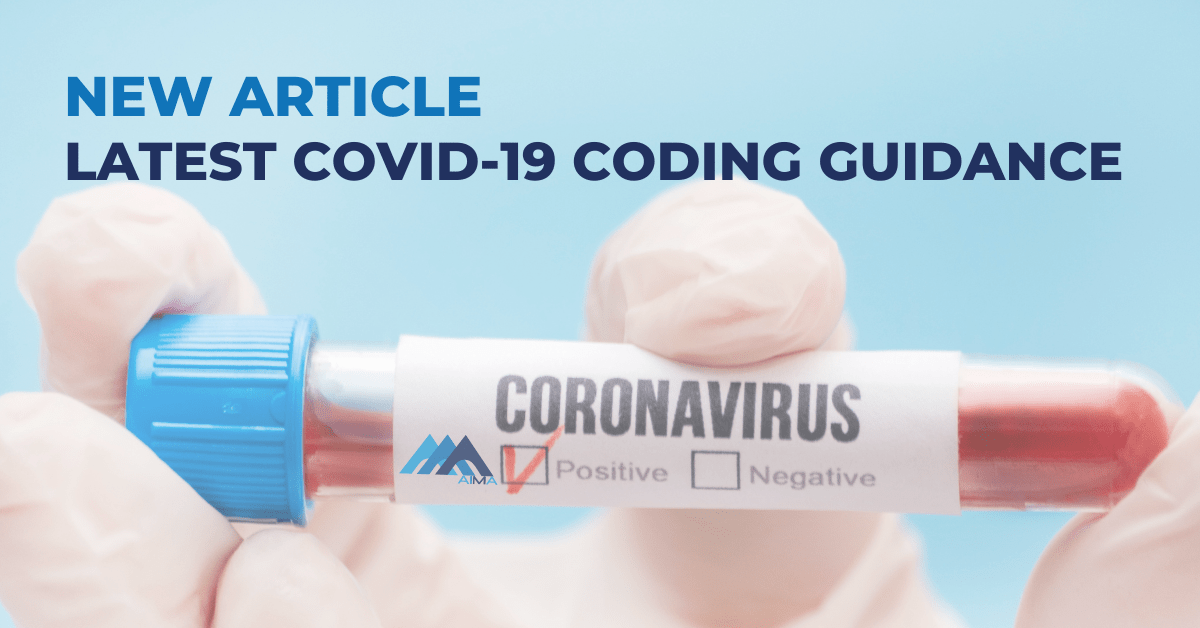The expert revenue cycle management team at AIMA have drawn together the very latest COVID-19 coding guidelines for US-based physician practices, laboratories and surgical centers.
Published on Tuesday 5th November 2020, the purpose of this article is to highlight the most up-to-date information regarding both the:
1. International Classification of Diseases, Tenth Revision, Clinical Modification (ICD 10 CM 2021) guidelines published by Centers for Disease Controls and Prevention (CDS)
2. Current Procedural Terminology (CPT) updates published by the American Medical Association (AMA)
1. Guidelines for ICD 10 CM 2021 Coding
- Code only a confirmed diagnosis of the 2019 novel coronavirus disease (COVID-19) as documented by the provider or documentation of a positive COVID-19 test result. For a confirmed diagnosis, assign code U07.1, COVID-19. This is an exception to the hospital inpatient guideline Section II, H. In this context, confirmation does not require documentation of a positive test result for COVID-19; the physician documentation that the individual has COVID-19 is sufficient.
- If the provider documents “suspected” “possible” “probable,” or “inconclusive” COVID-19, do not assign code U07.1. Instead, code the signs and symptoms reported. (guideline I.C.1.g.1.g)
- When the reason for the encounter/admission is a respiratory manifestation of COVID-19, assign code U07.1, COVID-19, as the principal/first-listed diagnosis and assign code(s) for the respiratory manifestation(s) as additional diagnoses. For example, COVID – related pneumonia instructs coders to report two diagnosis codes for the condition: U07.1 (COVID-19) followed by J12.89 (Other viral pneumonia).
- For asymptomatic individuals with actual or suspected exposure to COVID-19, assign code Z20.828, Contact with and (suspected) exposure to other viral communicable diseases.
- For symptomatic individuals with actual or suspected exposure to COVID-19 and the infection has been ruled out, or test results are inconclusive or unknown, assign code Z20.828, Contact with and (suspected) exposure to other viral communicable diseases
- During the COVID-19 pandemic, a screening code is generally not appropriate. For encounters for COVID-19 testing, including preoperative testing, code as exposure to COVID-19 (guideline I.C.1.g.1.e)
- For asymptomatic individuals who test positive for COVID-19, see guideline I.C.1.g.1.a. Although the individual is asymptomatic, the individual has tested positive and is considered to have the COVID-19 infection.
- For patients with a history of COVID-19, assign code Z86.19, Personal history of other infectious and parasitic diseases
- For individuals who previously had COVID-19 and are being seen for follow-up evaluation, and COVID-19 test results are negative, assign codes Z09, Encounter for follow-up examination after completed treatment for conditions other than malignant neoplasm, and Z86.19, Personal history of other infectious and parasitic diseases.
- For an encounter for antibody testing that is not being performed to confirm a current COVID-19 infection, nor is a follow-up test after resolution of COVID-19, assign Z01.84, Encounter for antibody response examination
- For follow-up testing after a COVID-19 infection, assign codes Z09, Encounter for follow-up examination after completed treatment for conditions other than malignant neoplasm, and Z86.19, Personal history of other infectious and parasitic diseases (guideline I.C.1.g.1.j)
Trust AIMA to help you achieve your financial performance goals with optimized systems and expert teams. We have in-depth experience at every stage of the revenue cycle; our flexible, scalable strategic solutions are bespoke to the needs of healthcare business owners. Read our case studies and testimonials to learn how we have transformed our customer’s commercial operations.
2. Guidelines for CPT Coding
- Effective from March 13, 2020, a new CPT code 87635 was introduced for infectious agent detection by nucleic acid (DNA or RNA); severe acute respiratory syndrome coronavirus 2 (SARS-CoV-2) (New Coronavirus disease [COVID-19]), amplified probe technique
- From April 10, 2020, 2 new CPT codes 86769 for Antibody; severe acute respiratory syndrome coronavirus 2 (SARS-CoV-2) and CPT 86328, immunoassay for infectious agent antibody(ies), qualitative or semiquantitative, single step method (e.g., reagent strip); severe acute respiratory syndrome coronavirus 2 (SARS-CoV-2) was added. CPT 86318 for Immunoassay for infectious agent antibody(ies), qualitative or semiquantitative, single-step method (e.g. reagent strip) was revised and re-sequenced
- Later on June 25, 2020, another new CPT 87426, Infectious agent antigen detection by immunoassay technique, (e.g. enzyme immunoassay [EIA], enzyme-linked immunosorbent assay [ELISA], immunochemiluminometric assay [IMCA]) qualitative or semiquantitative, multiple-step method; severe acute respiratory syndrome coronavirus was added
- Effective August 10, 2020, CPT codes 86408, Neutralizing antibody, severe acute respiratory syndrome coronavirus 2 (SARS-CoV-2), screen and CPT 86409, Neutralizing antibody, severe acute respiratory syndrome coronavirus 2, titer was added
- On September 8, 2020, two other CPT codes 86413, Severe acute respiratory syndrome coronavirus 2 (SARS-CoV-2) and 99072 for Additional supplies, materials, and clinical staff time over and above those usually included in an office visit or other non-facility service(s), when performed during a Public Health Emergency, as defined by law, due to respiratory-transmitted infectious disease were brought into effect
- Recently on October 6, 2020, 3 new CPT codes 87636 for Infectious agent detection by nucleic acid (DNA or RNA); severe acute respiratory syndrome (SARS- CoV2) and influenza virus types A and B, multiplex amplified probe technique, CPT 87637 for Infectious agent detection by nucleic acid (DNA or RNA); severe acute respiratory syndrome (SARS- CoV2) and influenza virus types A and B and respiratory syncytial virus, multiplex amplified probe technique and CPT 87811, Infectious agent antigen detection by immunoassay with direct optical (i.e. visual) observation; severe acute respiratory syndrome coronavirus 2 (SARS-CoV-2) were added. CPT 87426, Infectious agent antigen detection by immunoassay technique, (e.g. enzyme immunoassay [EIA], enzyme-linked immunosorbent assay [ELISA], fluorescence immunoassay [FIA], immunochemiluminometric assay [IMCA]) qualitative or semiquantitative; severe acute respiratory syndrome coronavirus (e.g. SARS-CoV, SARS-CoV-2 [COVID-19]) was revised

